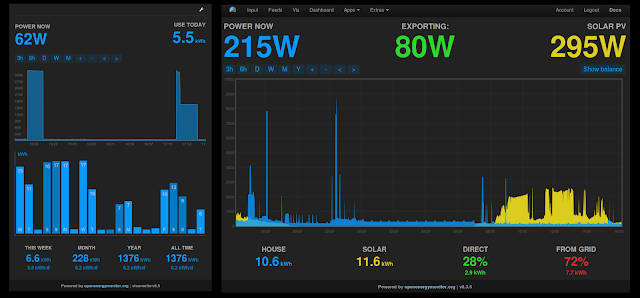At Watt Cost? A review of the emonPi Raspberry Pi based energy monitor
At Watt Cost ?
A review of the emonPi, a Raspberry Pi based energy monitoring system developed by OpenEnergyMonitor, by Lionel Smith :
Measurement is the first step that leads to control and eventually to improvement. If you can’t measure something, you can’t understand it. If you can’t understand it, you can’t control it. If you can’t control it, you can’t improve it.”
― H. James Harrington
― H. James Harrington
Do we know how much electricity can be saved by using low energy lighting such as LED's or how much electricity is saved by turning off lighting when not in use?
Finding out how much electricity is being used by one or all of your appliances, is the first step in being able to cut down on consumption, and in doing so spend less on electricity. It goes without saying that reducing your consumption equates to doing your bit towards creating a sustainable world.
Glyn Hudson, Trystan Lea and the rest of the team at OpenEnergyMonitor.org have developed some monitoring technology to help us understand and optimise our energy consumption and generation. This allows us to approach the problem of energy consumption in a logical and informed way.
The Raspberry Pi isn't great at measuring analogue voltages, so various Arduino based measurement boards have been developed which process and digitise the inputs and transfer them to the Pi.
In early 2014 an idea was born to create a shield which plugged directly onto a Raspberry Pi to make a single unit energy monitoring solution, primarily aimed at domestic users. A whole bunch of discussions and a fair amount of blood, sweat and tears culminated in a Kickstarter campaign which raised £24,723 to help bring the project to life
This piece of kit is dubbed the emonPi, which is a Raspberry Pi based, open-source, web-connected, energy & environmental monitor. This unit gives you the ability to measure home energy, solar PV, heatpump generation and temperature.
Everything on the site is fully open-source, which means you are free to tinker and improve to suit your needs. There is a very active community so help is readily available.
Aside from the obvious current and voltage values, temperature and humidity can also be measured by adding the appropriate nodes. All this information is then formatted on the Pi and either stored locally or uploaded via an Internet connection to a hosted application called EmonCMS.
Once you've built up some data, various visualisations can be applied to create some really informative graphs.
 |
| Emoncms MyElectric and SolarPV Dashboards |
The emonPi is available in both kit form or as a complete unit. Complete units are housed in a professional looking case sourced from Lincoln Binns. Even if you can’t resist the urge to experiment and order your system in kit form, it is highly recommended that you order the aluminium case to house the finished unit in. Aside from protecting everything inside, the case really gives the unit a polished, professional look.
Inside the case you will find a standard Raspberry Pi 2, the GPIO serial connected Arduino measurement shield and an I2C connected 2 x 16-character display.
The unit contains built in 433Mhz low power RF which is used for communicating with its external nodes. These nodes can be used to add additional power readings (emonTx) or remote temperature and humidity (emonTH) .
Fire up the system with a LAN cable plugged in and the on board display conveniently displays its IP address. Punch that into your favourite browser ( on a PC in the same LAN ) and you get to the login page. Once logged in, you are able to setup the WiFi if you have added an external USB WiFi adapter.
The built in 16 x 2 display will also confirm the status of connected devices. In order to measure temperature, an optional DS18B20 temperature sensor needs to be connected. The emonPi can talk to multiple (up to 6) of these sensors as they are individually addressable.
Power can be measured using a clip-on CT current sensor and a 9VAC reference supply. You can cheat and omit the 9VAC supply input resulting in the AC voltage being fixed in the software, but then you are not reading true Real Power or Power Factor, so this is not recommended. If measuring solar PV two clip-on CT sensors are required and the 9VAC voltage input is essential as it's required to tell the unit if you generating or consuming power. The second CT can be used to isolate a particular load and see how much that draws. As an example CT 1 could be measuring the total of your house while CT 2 could tell you how much just your water heater or stove uses.
Another method to measure power is to use an optical pulse counter sensor that picks up the LED flashes generated by most modern electricity and gas meters.
Being able to visualise the power used by your appliances gives a whole new insight into the power needed to run them. The author used the system to evaluate the claims made by the supplier of a hot water boiler control unit that only allows the boiler to heat the water 3 times a day based on your predicted usage. Using the emonPi and Emoncms system it was easy to see exactly how much saving was achieved after installing the control unit.
The emonPi is a fantastic piece of kit and well worth having if you would like to contribute towards a greener future.
Weblinks for more information:
Home Page – http://openenergymonitor.org/
emonPi User Guide - http://openenergymonitor.org/emon/modules/emonpi
Safety Warning: Interfacing with mains voltages can be potentially lethal. If you are not competent, or not sure of what you are doing rather seek the assistance of a qualified professional.
To engage in discussion regarding this post, please post on our Community Forum.